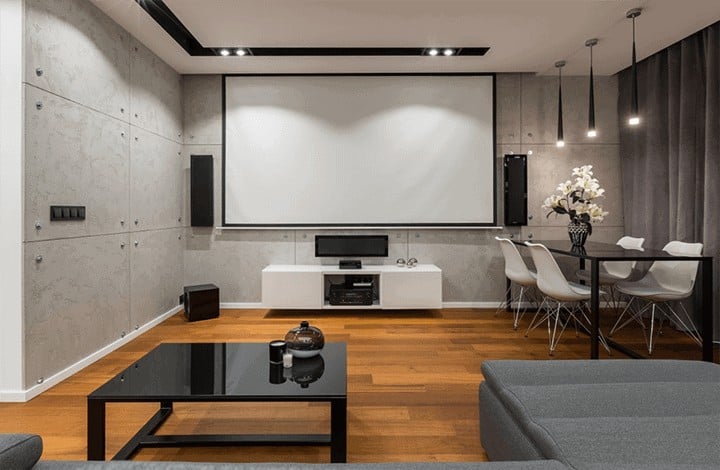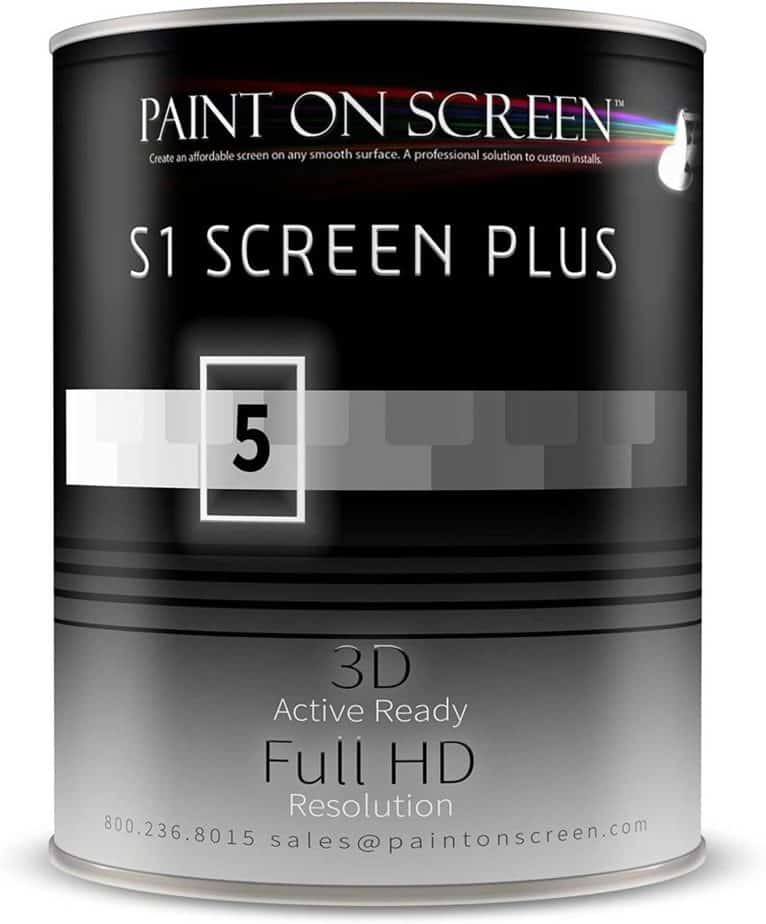If you’re looking to set up your home cinema. There are a variety of methods to accomplish this. The most common option is to make use of an LCD screen to serve as your projector. But this isn’t the only method you can create a projection screen for your home theater. Projector Paint vs Screen is the most common choice problem faced by the average home theater user.
It’s also possible to look into the use of a particular type of paint specifically designed to work by projectors. Projector to keep in mind it’s specifically designed to reduce any reflections, which are the most commonly encountered issue when projection directly onto the wall within your home.
It is known that it can offer a pleasant experience for viewing as well, with projector screen paint becoming the most utilized. However, considering that screens are the most sought-after option, is it worth spending a to spend the evening contemplating using a projector paint?
Let’s have a look.
Is Projector Paint as Good as a Screen? Can it be a viable substitute for the actual projector screen?
There is a noticeable difference between using wall paint and an actual screen for video projection. The paint and the finish you provide your wall surface will also affect how significant the difference is.
Let’s take a look at the benefits and drawbacks of using one of the two.

The Advantages: Why Projector Screen? What makes it the ideal choice for the majority of people?
The projector screen or projector screen material can be the perfect display for images taken of your projector and was specifically designed to do just that!
From the beginning of the concept through production to the delivery of your product to you as a buyer, screens are specially made to give you the most effective images. It’s an assembly made of a screen as well as a support structure.
There are a few reasons why you should choose to use projector paint; now, we must give the screens the chance to capture your attention too.
So let’s talk about the reasons you should think about using a projector screen.
1. Color and Light The greatest benefit
Projector screens feature a unique optical coating that allows for greater reflectivity of pictures. A projector has a defined line and design, which helps focus and direct the light of your projector to your eyes. It also aids in managing the steady flow of light and reflection throughout your viewing.
2. Frame: A-frame with a dedicated frame or a frame that is not. Your frame
Although you can make a DIY frame using a projector paint on your wall, however, not everyone knows how the best way to go about it, and, most importantly, it’s not the same as the frame you get together with your screen.
3. Mobile: Carry it with you wherever you’d like all over the world
You can change the position of the projector screen all around. Therefore, whether you want to loan it to your local town hall, or to make an event at work, you can take your projector screen can take the journey with you, without having to take it off your wall (no shade!).
4. Simple and quick to set up: It takes not any time at all
The process of setting up your projector screen requires the assistance of a specialist, but it’s not a hassle. All you have to do is find an expert technician and in no time you’ll be eating popcorn or a gamepad.
The downsides: A few disadvantages of using the Screen of a projector
Although a screen is supposed to deliver the ideal viewing experience with a projector, if you place it side by side with its alternative(projector paint), it has some disadvantages.
1. But not so flexible: Dimensions are everything, don’t forget the opportunity to do so!
A bottle of projector paint usually covers a full wall in most cases, and should you ever have to extend its size screen then it won’t be a huge deal. However, this isn’t always the case for projector screens. It is essential to find the correct dimensions to match your projector’s display precisely.
2. Screens are expensive. Expensive does not always translate to better quality.
Screens are more valuable as a result, which is why they typically cost more. But, it all depends on the type and quality of the screen you choose.
3. It takes to more space: Mounting sucks!
Because projector screens have a more specific size and length and width, they will use up more space. But, there are ways to place this onto your wall or ceiling for a long time.

Is projector paint worth it?
The best answer could be: projector paint can be worth the investment due to a variety of reasons. It’s an excellent option when you’re in search of an alternative to a screen that takes up little room in your home.
But painting on a wall with a particular appearance could be distracting when you’re watching an upcoming film.
Since a lot of us have rough walls in our homes This is the most significant issue you may face when you use projector paint. If there isn’t a smooth white wall to paint on and this could turn you off applying paint instead of a different alternative.
There are other factors you must consider when deciding which paint or screen. screen. Let’s take a look at the various paints that can be used in conjunction with projectors. projector.
What color projector paint should I use?

- White Wall Projection
- Gray Wall Projection
- Silver Wall Projection
You’ve decided that projector paint is the best choice for you, but now you’re struggling to determine the ideal color for your screen because there are numerous options. I’ll also provide some tips to help you choose the choice.
1. White: This is by far the most favored one that is known for its superior reflection
It is the white color that’s the most sought-after option to use for wall screen projectors. This is because white is the most reflective paint, white object naturally reflects any other color.
2. Gray: It provides better contrast and black levels
If your office or bedroom walls are already painted gray, and you don’t wish to change them? It’s a good thing. Grey paint is the best choice for higher contrast and black levels and you don’t need to alter the appearance of your room particularly if you have ambient light.
3. Silver: Somewhere in between Gray and White
The silver paint is a color that is similar in color to white projector paint, so it’s also very reflective. This means that you can apply the silver projector paint and still take in the view even when there’s not enough light from the lamp.
How can you make use of the wall to serve as the screen? screen
1. Smooth and smooth the wall to the greatest extent you can
The goal is for your painted wall so smooth as possible and with as little texture as is possible. As mentioned, tiny crevices and bumps on the wall create tiny shadows appear.
You’ll need to switch the lights off and then use an emergency light source If you own an existing projector already, you can project an image on the wall. This will help you identify any troublesome areas. You can use a pencil or other to mark the areas.
Once you have marked these areas then use sandpaper or a power sander to smoothen the wall. It is important to be able to smooth then paint the wall several times to make it to a wall so smooth and even as you can. An even wall is a happy wall!
2. Paint the wall
The most efficient method of using a projector on an entire wall is to paint the wall using projector screen paint. It’s not completely required, but it does allow for the wall to reflect light more effectively. The problem with this kind of paint is that it’s expensive.
My recommendation would be to paint this area first with normal white paint or primer. After sanding, reapplying, and so on. Then, you could apply a thin layer of painted screen over the same area.
If you have only one quart of paint then applying 1 or 2 coats of thinner paint over an ordinary white paint or primer is an excellent option for those who are working with a limited budget.
The most effective solution is to use several coats of screen paint, but you are likely to require more than a quarter of a quart to accomplish this.
The majority of the time, you’ll use white screen paint, however, if your projector is very bright with a large luminous number (around 3,500) you might want to consider using gray paint.
A 3,500-lumen white screen will feel slightly blinding. A lot of light could be reflected directly into your eyes.
However, most of the time you’ll find that a simple white screen paint is the most effective option. It is not necessary to be able to paint your wall with a specific screen paint but it’s certainly a nice option.
3. Create a frame surrounding the projected image
Frames are an essential element to any screen! A distinct border surrounding the screen assists the user to focus on the high-quality image. This is more crucial than you believe, I swear! Most screens include an outline of black surrounding an area of projection area because it boosts the image quality.
It provides a clear start and a clear endpoint to where the image will be projected. The frame helps to keep the eyes focused on the content being shown and not on exactly where the edges of the screen are.
Certain people, including myself, struggle to focus on tiny small details. Things like the edges of the image projected by a projector can cause a lot of distraction. The frame can also boost its contrast with the wall as well as your image.
To make a frame that is easy to construct start by setting the projector in the ideal position. After that, you can project the entire image on the wall and make use of a pencil to draw all around the projected image.
After marking the area, use black velvet tape to outline the space. If you would like the frame to look more attractive, construct a wooden frame according to the size. I suggest wrapping every piece of the frame with a thin black carpet. This is exactly what we did and it looks amazing!
Conclusion
Overall the best option for both is the one with an excellent projector screen. In this way, you’re getting an extremely smooth surface, and you’re likely to be capable of using your projector easily.
There are advantages when you choose to use projector paint as well. It’s less expensive to purchase the screen as well as the paint task will require the least amount of space in your theater room or lounge. It all depends on what you’re trying to accomplish.
